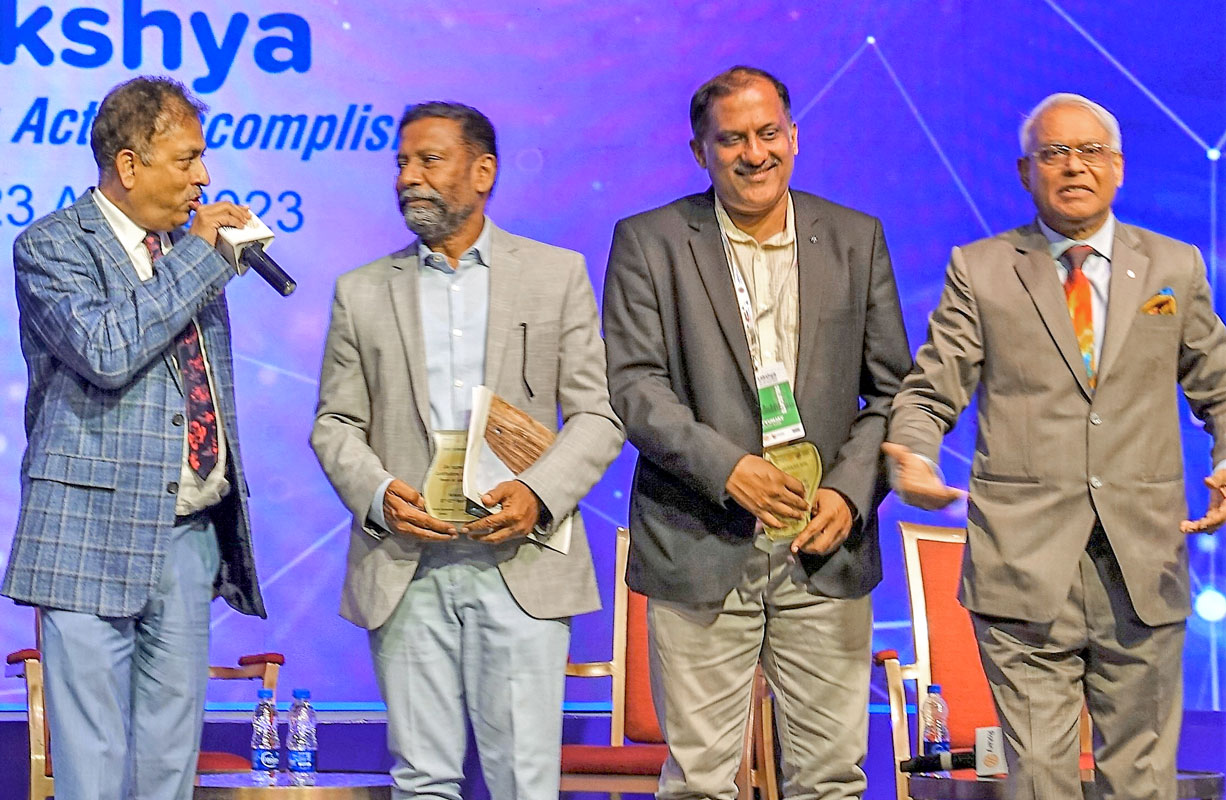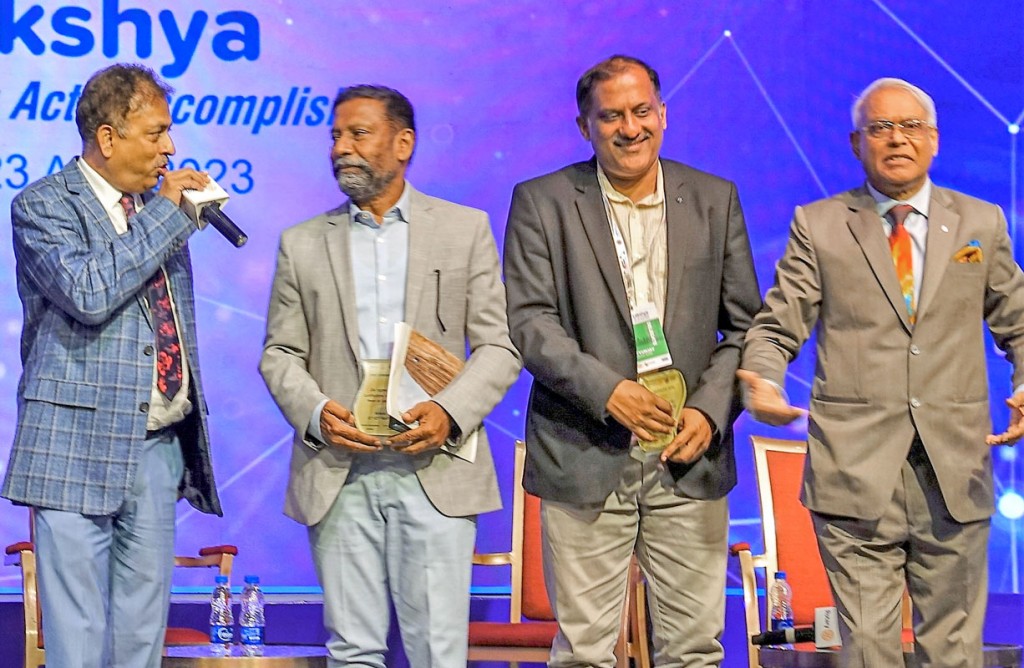
One of the highlights of the training event Lakshya, held in Kolkata recently for the DGEs and DGNs was a session on the environment chaired by RI director Mahesh Kotbagi. The audience was all ears as Ravishankar Dakoju, the mega donor to TRF, explained how under the leadership of RC Bangalore Orchards, RID 3190, of which he is a past president, and members such as Neil Michael Joseph, the cyanide dumps at the KGF township in Kolar district of Karnataka were transformed from a toxic hellhole to a green area filled with trees, birds and animals.
He explained that the British had extracted gold from the Kolar gold fields; “to do that you need to use cyanide to separate the gold from the slurry.” Once the British left, the mining was stopped and the whole area dried up, and “the residual cyanide dust blown by the wind wreaked havoc on the health of the people in the KGF township, causing cancer, tuberculosis and other diseases.”
This was considered a lost cause till Rotary stepped in, built a partnership with the local government and won its confidence. To green the area, “we dug trenches at different levels, each trench being 14x2x2ft. About 14,000 trenches were formed at different levels, and in each trench trees and cactus, along with wild grass, were planted. The grass retains the moisture and binds the soil.”
The trees started growing but hit a rough patch at some point and started dying. What was needed was compost or manure to sustain the greenery.
“Believe it or not, we had to literally ‘smuggle’ the compost all the way from Bengaluru to Kolar, because the transport of the smelly manure was not allowed. But we Rotarians never give up. We don’t mind failing… I am a failure throughout my life; failed in Class 10 three times, and just about managed to pass Class 12! Anyway, we used to transport it at midnight and we filled all the 14,000 trenches with 700 tons of compost brought from Bengaluru to Kolar,” said Dakoju, amidst applause.
“Finally, we won and the cyanide started giving up.” The Rotarians planted 1.2 lakh saplings and 15,000 cacti and “we want to make it a forest land. We’ve planted Singapore cherries and now the birds come, and so do snakes, rabbits and black bucks.”
This success story was a great compliment to Rotary; the government had given up saying this is a highly poisonous region and nothing can grow here. “But as PRIP Shekhar Mehta said: ‘You should be either mad, passionate or courageous to face failure. We did that and we won.”
Along with PDGs Suresh Hari and K P Nagesh, Dakoju, who has now joined RC Bangalore, has initiated a new project, “where we are taking up 1,500 acres to make a mini forest in one of the driest areas of Karnataka. It’s an ambitious and comprehensive project which will cost Rs 26 crore to put up five lakh trees, restore two lakes, put up grasslands, protect the animals and enhance the livelihood of the 8,000-odd tribals in the area. Meenakshi Venkataraman, director, Projects, ESRAG (Environmental Sustainability Rotary Action Group) is helping us. She tells us, develop grasslands, don’t just keep planting trees.”
Admitting that this was “a very ambitious project,” he added, “this is called thinking big… we don’t want to put up a park or a plantation but an entire forest, and thus give something back to the planet.”
Addressing the meet, Meenakshi said that Rotarians in both Asia and Africa will have to respond to the environmental crisis that was unfolding; Pakistan had seen flash floods last year and Sri Lanka had faced the nightmare of its agricultural systems collapsing.
Saying that funding was going to be available for environmental projects, she talked about projects involving pollination, adopting a river, reduction of carbon and methane from the environment. “Three ways we can reduce that is by working on the soil, on mangroves and coral reefs.” Shekhar Mehta, as RI president, had announced at the UN Conference on Climate Change that Rotary would do large projects on developing mangroves. She was happy to tell the participants that as many as 30 global grants were in the pipeline for this work.
Expressing concern about the missing data on projects done by Rotarians, Meenakshi, who is a member of RC Nilgiris West, RID 3203, said, “We need to measure our impact as Rotarians. We all rose up to PRIP Ian Riseley’s challenge of planting trees, but no one seems to know how many trees were planted.”
RID 3141 DG Sandip Agarwalla gave details of the biodiversity park that his district, under the leadership of his club RC Bombay, had put up in the Bombay University over an area of 1 ½ acres. “There we have put up a bamboo growing Zen garden, an amphitheatre, revived a lake and put up a huge rainbow model from recycled material.” The trees have been QR coded and the Rotarians will be involved in the development and maintenance of this park for the next 10 years. “We have appointed a naturalist and started getting schoolchildren in groups of 40–50, who spend 4 to 5 hours with the naturalist going around the park and connecting with nature.”
Since the park will be under their care for the next 10 years, “we are going to add to it incrementally. Already we have put up a mini windmill and an interactive fountain; when children pedal on static cycles, the water starts falling. Rotaract clubs have shown some interest in adding to this park with lots of creative ideas,” he added.
Mrutyunjay Suar, head of KIIT Incubator, said he came from a “university bringing the innovation culture and an ecosystem called ‘incubator’ promoting more than 380 companies started by young minds thinking of solutions for society.”
People he worked with were engaged in making inexpensive products; “we bring in to solve local problems the best minds, policymakers, innovators, intellectuals, and give solutions that are scalable, sustainable and affordable.” An example he gave was of extremely cheap technology to test the potability of water in rural areas; “it costs just a few paise.”
Complimenting Rotarians for the several projects they have undertaken on environmental sustainability, RI director Kotbagi said, “We have to understand the importance of reducing carbon emission. Today regulations are in place and many industrial houses are keeping a close watch on this. Developing mangroves is a wonderful project of Rotary, and we need to continue the good work done in this area last year.”
Picture by Rasheeda Bhagat






